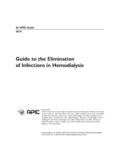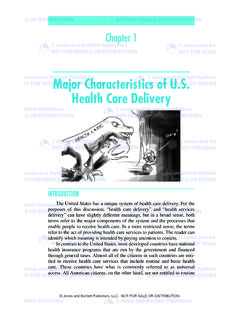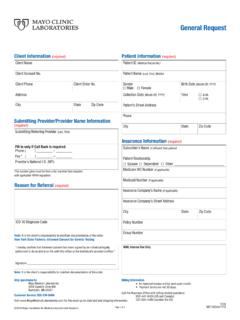Transcription of Public Health Classics - World Health Organization
1 139 Bulletin of the World Health Organization | February 2004, 82 (2)This section looks back to some of the ground-breaking contributions to Public Health , reproducing them in their original form andadding a commentary on their significance from a modern-day perspective. William D. Savedoff reviews the 1963 paper by KennethArrow that launched the discipline of Health economics; extracts from the original article are reproduced by permission of theAmerican Economic Health Classics1 Health Financing and Stewardship, Evidence and Information for Policy, World Health Organization , Geneva, Switzerland (email: No. 03-006445 Kenneth Arrow and the birth of Health economicsWilliam D.)
2 Savedoff1 Forty years ago, Kenneth Arrow published Uncertainty and thewelfare economics of medical care in The American EconomicReview (1). This paper became not only one of the most widelycited articles in the field of Health economics indeed, it markedthe creation of the discipline but also a source of reference inother fields. A search on the ISI Web of Knowledge generated771 citations that include journals in all parts of the World and infields as varied as Public choice, sociology, banking, education,environment, law and clinical practice, and even space , the article s relevance is far from diminishing overtime: citations between 1991 and 2000 were five times morenumerous than those between 1963 and 1972 (2).
3 The first reason for this article s continuing popularity isits intellectual elegance and insight. The second is that it toucheson a core feature of Public Health policy debates: the extent towhich market or non-market institutions play fundamental andsocially desirable roles in the provision and distribution of healthcare 1963, Arrow was already well established as a leadingeconomist, having published (with Debreu) seminal work oncompetitive equilibrium that provided the foundation for moderneconomic thinking about the extent to which markets can orcannot reach welfare-maximizing equilibria. Previously, he haddeveloped the impossibility theorem for which he later won theNobel Prize. In that work, he demonstrated the difficulty offinding any collective decision-making process that can provideconsistent ordering of social had not previously written about Health and rarelyreturned to the subject in his subsequent work.
4 The articleextracted here resulted from an invitation from the Ford Foun-dation to promote greater exchange between economists andother professions in the areas of Health , education and therefore had to learn about Health care and Health insur-ance services before he could apply himself to the article begins with reference to the desirable propertiesof perfectly competitive markets, using concepts from Arrow sgeneral welfare theorems. He then explores how the existenceof uncertainty in the incidence of disease and in the efficacy oftreatment leads competitive markets to generate an inefficientallocation of resources and contributes to the emergence of non-market institutions (such as trust and norms) that compensatefor these market demonstrating the kind of market failure that derivesfrom uncertainty and related problems of information, Arrowhelped to generate a vast literature dealing with problems inmarkets ranging from Health insurance to used cars (3, 4).
5 He alsoopened the way for agency models to be applied to studies ofphysician behaviour (5).By developing the implications of uncertainty on marketsand market equilibria, Arrow established principles that have beenfound useful in subjects other than Health . His insight appliesto any analysis in which costly information compromises a system sability to generate preferred aggregate outcomes from decen-tralized actions. It is this generalized applicability that accountsfor the article s wide range of citations across various article was written, however, specifically about healthcare (Arrow is careful to stipulate that he is discussing only medicalservices and not Health per se), and its longevity also derives fromits comprehensive treatment of the central issue in most publichealth policy debates: what roles are effectively played by marketsand what roles are best left to non-market institutions.
6 The articleis sometimes cited to demonstrate that Health care is not asexceptional as many people claim and that market mechanismscan play an effective role in the medical care industry in the sameway as they do in other economic activities (including sectorswith an effect on Health , such as food and housing). In contrast,it is also cited to demonstrate that market failures in Health carejustify the creation or preservation of non-market writes that non-market institutions can (but notnecessarily do) enhance the efficiency of the medical care this respect, he cautions against viewing all efforts by physi-cians to ration entry to medical schools or to require professionallicensing as mere ruses to raise their goes further to conjecture that, in situations wheremarkets fail, societies will create non-market institutions to correctthe resulting inefficiencies.
7 This conjecture has proved contro-versial, yet it provides fertile ground for developing theories onthe formation of social institutions. To follow Arrow, such atheory would have to take account of conditions under which140 Bulletin of the World Health Organization | February 2004, 82 (2) Public Health ClassicsKenneth Arrow and the birth of Health economicsWilliam D. Savedoffdifferent interest groups find ways to cobble together socialinstitutions that are mutually beneficial, even when such insti-tutions may require some degree of self-restraint or compromiseon the part of those same many ways, it is remarkable that Uncertainty and thewelfare economics of medical care has stood the test of 1963, medicine still consisted largely of a single physiciantreating a single patient with relatively rudimentary remediesand medications.
8 Since that time, medicine has been revolu-tionized by technological advances in the understanding andtreatment of illnesses, and rising incomes have stimulated highand increasing levels of the United States of America in the early 1960s, govern-ment involvement with medical care was limited; insurancecovered less than half of all medical expenditures, compared withabout 85% today. Since then, Health care has been transformedby, among other things, Medicare and Medicaid, malpractice,and managed care. The non-market institutions that Arrow hadobserved, such as trust that physicians would not be motivatedby profit and beliefs that the medical profession could regulateitself, have , changes in Health care have been no lessremarkable.
9 Spending on Health services has increased dramati-cally in all of the World s high- and middle-income countries,leading to increased concerns about cost-containment, qualityand responsiveness. Many of these countries, even if they havepredominantly Public systems, have introduced more marketelements to relieve pressure on Public services or to encouragegreater productivity and allocative Arrow KJ. Uncertainty and the welfare economics of medical care. TheAmerican Economic Review 1963;53 Kenneth Arrow and the changing economics of healthcare (specialissue). Journal of Health Politics, Policy and Law 2001;26 Rothschild M, Stiglitz J. Equilibrium in competitive insurance markets:an essay on the economics of imperfect information.
10 Quarterly Journalof Economics 1976;90 in developing countries run high, as rising aspira-tions continue to outstrip the local resources available to meet in Latin America which had hoped to follow thewestern European models of social insurance expansion havebeen blocked by the slow expansion of the formal labour marketand low productivity in Public institutions. In most of Asia,private fee-for-service arrangements continue to dominate, withfew insurance products emerging. The former communist nationsof eastern Europe and central Asia are dealing with the collapse ofnational Health services and turning to social insurance arrange-ments, while African countries are struggling under extremelylimited resources and increasing disease burdens, notably fromthe spread of fact, no country today appears to be happy with itshealth system.
















